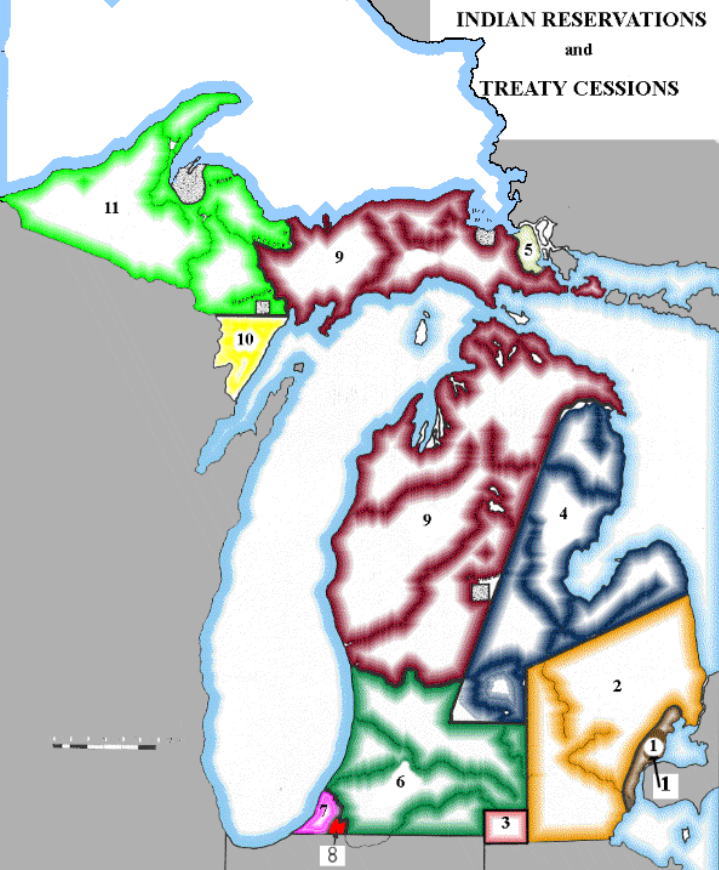
Design
At the core of Six Degrees of Great Lakes Treaties is an interactive visualization of connections between approximately 1,600 Anishinaabe and American signers of 24 treaties beginning with the Treaty of Greenville (1795) and ending with the Treaty of Detroit (1855). It can be viewed by clicking the "Visualization" button above. Initially, the aim of this project was to analyze the signers of 11 treaties that resulted in the cession of Indigenous Lands (pictured to the left) the United States government would eventually consolidate into the state of Michigan. However, it soon became clear that concentrating solely on these documents would produce an incomplete work of digital cultural heritage. In the decades following European contact, Ojibwe, Odawa, and Potawatomi peoples who called what is now Michigan home (indeed, whose descendants continue to call it home) navigated between borders Euro-American powers were attempting to cement. They transgressed territorial and national lines which remained remarkably permeable well into the nineteenth century.
Thus, what started as a Michigan story quickly broadened to encompass most of the Great Lakes region, and it raised an assortment of important questions along the way. How, for instance, might Indigenous mobility in such a space coupled with Anishinaabe and American individuals' participation in multiple treaty negotiations have complicated American expansion and state formation efforts? Furthermore, what kinds of individuals repeatedly appeared to sign compacts with such significant consequences? The visualization Six Degrees of Great Lakes Treaties presents will hopefully help untangle the twisting and turning relationships late-eighteenth and nineteenth-century treaty signers shared. Visitors to this site can aid in that endeavor by leaving comments or critiques on the project dataset. Data was scraped from treaties listed in the "Sources" section below and cleaned using OpenRefine.

Scholarly Potential; or,
A Tale of Two Compacts
To better understand how Six Degrees of Great Lakes Treaties could enrich analyses of late-eighteenth and nineteenth-century treaty negotiations, an examination of two documents is beneficial. First, there is the deed to Mackinac Island (pictured to the right), which Ojibweg in northern Michigan sold to the British government in 1781. On display in the deed are pictographs symbolizing the clans (or nindoodemag) of the Ojibwe signers who the document characterizes as "Representatives and Chiefs" of the "Nation of the Chipiwas." Perplexingly, though, none of these pictographs seem to resemble those of nindoodemag most commonly present at contemporary diplomatic engagements. Historian Heidi Bohaker argues that "frequency variations [among nindoodem pictographs] reflect the political importance of some clans at specific locations." So, why would British officials invite members of nindoodemag whose presence around Mackinac Island was less pronounced than others to act as representatives at its sale? Considering a second document presents a potential explanation...
Following the intercession of Indian Agent Henry Rowe Schoolcraft behind the backs of Ojibwe and Odawa diplomats, the Treaty of Washington (1836) led to the cession of over one third of the future state of Michigan to the United States government. Well before negotiations began, however, Schoolcraft was already maneuvering to boost Anishinaabe receptiveness to American terms. He dispatched his mixed ancestry brother-in-law, William Johnston, to Sault Ste. Marie to recruit some of his kinsmen to serve as Indigenous ambassadors. Consequently, Ojibwe leader Waub Ogeeg traveled to Washington, D.C. even though, as scholar Charles E. Cleland asserts, he was "of the addik, or caribou, totem from western Lake Superior and...[therefore] not [one of the] legitimate speakers for people who resided at Sault Ste. Marie." Schoolcraft surely hoped that one of his relatives could sway other Anishinaabe leaders despite the dubiousness of his position as a proxy for his community. Thinking back to 1781, could the British have similarly brokered Mackinac Island's sale with Ojibweg they shared especially strong relations with regardless of nindoodemag?
Key Considerations
COMING SOON!